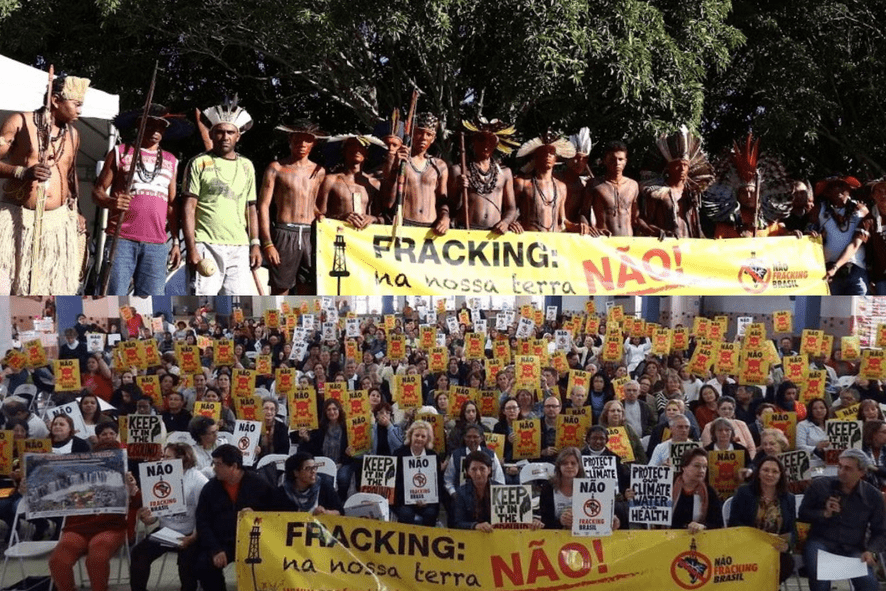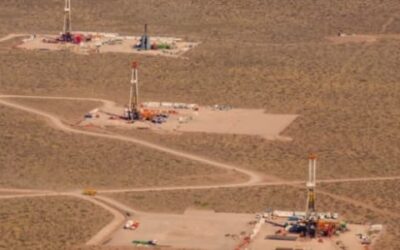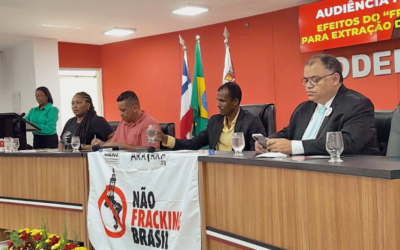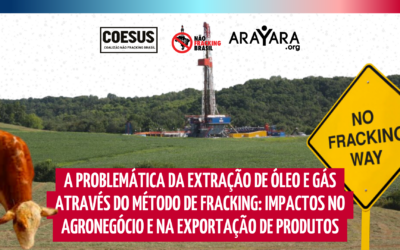Government will launch public notice to stimulate fracking in Brazil

By Agência Pública | Anna Beatriz Anjos 06/14/22 14:10
The federal government is about to launch the public notice for the “Transparent Well” project, which will encourage the exploration of unconventional gas and oil reservoirs in Brazil through techniques such as hydraulic fracturing, popularly known as fracking. The practice, which transformed the United States into the world’s largest hydrocarbon producer and was banned in countries like Germany, France, and the United Kingdom, is related by science to environmental impacts and risks to human health.
Although the efforts to put the project on its feet did not begin in Jair Bolsonaro’s government – the intention to unlock the production of unconventional resources was already discussed in the scope of the first version of REATE (Program of Revitalization of the Activity of Exploration and Production of Oil and Natural Gas in Terrestrial Areas), whose final report was published in October 2017 – the government plan of the then candidate for the presidency in 2018 already preached the “incentive to unconventional exploration” of oil and gas and advocated that it could be “practiced by small producers”, against “the monopoly of Petrobras over the entire fuel production chain.”
As soon as the public notice is published – which should occur in “mid-June”, according to the Ministry of Mines and Energy (MME) informed the Public Agency through the Access to Information Law (LAI) – companies that want to do fracking in unconventional wells in blocks or fields under its concession can submit proposals, which should be selected by the ministry. A draft of the public notice, submitted for public consultation from March 30 to April 29, states that “one or more projects” can be qualified.
One of the main stakeholders in the program is the gas exploration sector – a fossil-based resource – which sees the Transparent Well as an opportunity to leverage its production. Eneva, the largest private operator of natural gas in Brazil, has already expressed its intention to submit a proposal to perform fracking in the interior of Maranhão, where it owns a complex consisting of four thermoelectric plants and gas production fields.
Close to entering the practical phase, the Transparent Well has existed formally since May 2020, when it was launched under the Investment Partnerships Program (PPI), of the Ministry of Economy, “for the purpose of supporting environmental licensing and other measures necessary to make the project viable.” Like all initiatives qualified by the PPI, the program is framed as a priority, allowing the government to expedite its feasibility.
Alternative to “break the ice” with society
Among companies, there is the expectation that the Transparent Well will make it easier to obtain environmental licenses for non-conventional ventures. Among companies, there is the expectation that the Transparent Well will make it easier to obtain environmental licenses for non-conventional ventures. Today, fracking is not allowed in Brazil because there is no specific regulation for the environmental licensing process necessary for its realization, as determined by a resolution of the National Agency of Petroleum, Natural Gas and Biofuels (ANP).
In addition, court decisions have invalidated the concession contracts for blocks with potential for gas exploration through fracking auctioned by the ANP in 2013, in its 12th round, the first to offer onshore areas with these characteristics. The Federal Public Ministry (MPF) played a decisive role in this aspect by filing public civil actions requesting the suspension of the contracts due to the lack of prior environmental studies of the sites where the exploration would be carried out, fundamental, according to researchers, to ensure the safety of the operations. Laws were also approved prohibiting the activity in two states, Paraná (specifically for gas exploration) and Santa Catarina (for gas and oil), after mobilization by civil society facilitated by environmental movements such as the Coalizão não ao Fracking Brasil (COESUS).
Faced with the unfavorable scenario, the federal government bet on the creation of a pilot project with the argument of testing hydraulic fracturing in the country, inspired by similar initiatives elsewhere in the world, such as SHEER (Shale Gas Exploration and Exploitation Induced Risk), in Poland; the MSEEL (Marcellus Shale Energy and Environment Laboratory), in the United States; and the PPII (Proyecto Piloto de Investigación Integral), in Colombia.
Waving the flag of transparency, the federal government has set as the main objective of the Transparent Well to allow society to follow – through data made available on the internet, for example – the execution of the selected projects and their operational practices “so that they occur in an environmentally safe way”, according to an e-book prepared by the ministries of Mines and Energy and Economy, ANP and Energy Research Company (EPE). The document says that the purpose of the initiative is also to generate knowledge about the country’s unconventional reservoirs.
In another notebook produced by MME and EPE, this time in partnership with FGV Energia and Rede Gasbras, the secretary of Petroleum, Natural Gas and Biofuels of the ministry, Rafael Bastos da Silva, signs an article in which he affirms that “the Transparent Well Project has the potential to open the access to non-conventional resources in Brazil, conferring the amplification of the possibilities of energy sources”.
However, environmental organizations criticize the government’s attempt. “The ANP’s idea was: nobody likes fracking, so I’m going to do greenwashing and invent a business called Poço Transparente (Transparent Well). You don’t need to be afraid, because there will be transparency in what will be happening, and therefore we will give you the security that this technology is reliable”, says engineer Juliano Bueno de Araújo, founder of Coesus and of the Arayara Institute, which has been following the fracking agenda for at least a decade.
For him, the Transparent Well “is nothing more than a big technical and scientific fake by the ANP, which created a cellophane package about a technology that is absolutely the same [as fracking], to make wells viable in some regions of Brazil and generate the commercial viability of Brazilian shale.
Edmilson Moutinho dos Santos, a professor at the University of São Paulo’s Institute of Energy and Environment (IEE-USP), who coordinated the Gasbras Network of research on unconventional gas in Brazil – the project brought together, until 2021, several Brazilian universities – also sees in the creation of the Transparent Well an attempt to soften opposition to fracking in civil society. “How have many countries dealt with trying to break the resistance and invert a little bit the social perception of the thing? We came up with this idea of transparent wells, done with typical company operations, as will be done one day if the company is going to operate. It’s not a laboratory, it’s a real activity, but with scientific and social monitoring,” he describes. “In some places, [this kind of exercise] has been very positive, in others, it hasn’t been very effective, but it’s a way out that is considered good to break the ice [with society].”
What is fracking
“Shale” is the term popularly used to refer to shale, one of the unconventional rock formations in which gas and oil can occur. There are also “tight” sandstone or carbonate reservoirs with oil and gas (tight oil and gas), among others. All these rock types are of low permeability, more difficult to exploit than the typical reservoirs, which produce conventional oil and gas.
According to the EPE, potential reserves of seven types of unconventional resources were mapped in 14 Brazilian sedimentary basins, highlighting, in terms of variety, the Paraná (which extends over Mato Grosso, Mato Grosso do Sul, Goiás, São Paulo, Paraná, and Santa Catarina), Parnaíba (which covers parts of Pará, Maranhão, Piauí, and Tocantins), and Recôncavo (Bahia).
With regard to shale gas – which has made the United States the world’s largest gas producer – the Parnaíba, Paraná, Recôncavo, Solimões (in Amazonas) and Amazonas basins (in Amazonas, Pará and Amapá) are the most promising. The U.S. Department of Energy Information (EIA) ranks Brazil as the tenth country with the most resources in leaf gas on the planet.
For the commercial operation of these unconventional reservoirs to be viable, more complex techniques are required. First, the well is drilled vertically until the layer of rock to be explored is reached, which is usually at depths of 1.8 to 3 km below the surface. Thereafter, drilling continues horizontally for a distance ranging from 1 to 3 km, and, at the end of this process, the well is cased with steel pipes and cemented. Then comes hydraulic fracturing: the injection of large amounts of water with various chemicals (in the scientific literature, there are more than a thousand chemical components already used in the operations) and sand under high pressure, which produces fractures in the rocks, allowing previously inaccessible gas and oil to flow into the pipe and be extracted.

In public consultation, companies and entities seek relaxation of rules and tax incentive
In the twilight of 2021, on December 30, President Jair Bolsonaro approved a resolution of the National Energy Policy Council (CNPE) determining that a draft of the Transparent Well notice be submitted to public consultation. This occurred through a form that was available from March 30 to April 29 of this year on the MME’s public consultation page.
Although, according to the MME’s own website, the tool should serve as an “interaction channel” between the portfolio and citizens “to allow popular participation in public management,” Pública verified, through data accessed via LAI, that most of the manifestations on the form came from companies and entities in the sector. Of the 57 suggestions sent, 53 were proposed by the Brazilian Association of Independent Oil and Gas Producers (Abpip), the Brazilian Institute of Oil and Gas (IBP) – both represent companies in the industry operating in Brazil – by Eneva and by Schlumberger, a multinational oil and gas service provider. The other four were sent by Rede Gasbras.
The results of the consultation make it even more evident that Eneva plans to invest, through the Transparent Well, in unconventional resources in the Parnaíba Complex, located in the region of Santo Antônio dos Lopes (MA), 300 km from the capital, São Luís – there, the company already operates ten gas production fields. The intention was expressed in an event for investors in February this year, when Eneva disclosed that it plans to explore four unconventional wells in the region; at that time, one of them was already drilled and prepared for “stimulation and testing”. Pública had access to the document with the information.
The only manifestation of Eneva – whose main shareholders are BTG Pactual and Cambuhy Investimentos, a fund from the Moreira Salles family – in the questionnaire proposed a kind of “well thought out”. According to the law, as a thermoelectric generator operator, it must annually allocate 1% of its net operating revenue to investments in research and development in the electricity sector. Since the Parnaíba Complex is a “power plant at the wellhead” model enterprise – that is, one that produces and burns gas, generating electricity in the same place – the company suggested including the investments in non-conventional exploration, in the scope of the Transparent Well, in these obligations before the National Electric Energy Agency (Aneel). This would help its business on two fronts: increasing the availability of fuel to feed its generation park and, once this sustainability is assured, diversifying the monetization options for its gas. This is also stated in the letter to shareholders published by the company’s CEO, Pedro Zinner, in March of this year about the company’s operations in 2021.
Another aspect that benefits Eneva was addressed by Abpip and IBP. One of the sections of the draft establishes that, for a project to be accepted, there must be a minimum distance of 1,500 meters between the well drilled for fracking and an aquifer that can be used for domestic or industrial purposes. Abpip requested the deletion of the paragraph, arguing that the definition “is out of line with the best practices of the onshore industry and could make the inclusion of important assets in the public notice unfeasible”. The company cited as an example the Parnaíba sedimentary basin, where Eneva’s operations are located in Maranhão, responsible for “the second largest onshore natural gas production in the country. According to Abpip, wells with unconventional potential in that region are between 1,200 and 1,400 meters away from aquifers – which would not respect the limit determined by the first version of the public notice. If the request to exclude the stretch is not met, the entities suggested that the veto to projects happens “when there are no technical studies that demonstrate that the execution of the transparent well will not affect the base of an aquifer that can be used for domestic or industrial purposes.
Risks to air, land, water, and human health
The problem is that this process can lead to a series of environmental consequences, as science and the impacted communities have been pointing out over the years.
One of the most notable are the significant emissions of greenhouse gasses (GHG), the major contributors to global warming, not only in the exploration and production stages of the shale gas, but also in the heavy machinery used in the operations and in the intense movement of transport vehicles – which also causes a worsening of local air quality. There are also “fugitive” emissions of methane, a powerful GHG, which occur at times when fluids are injected into wells and returned to the surface (the “return water”) to extract the oil or gas. A 2019 study found that, during the previous decade, U.S. baseload production of shale gas may have contributed to more than half of the increase in fossil fuel-derived emissions across the planet and to approximately one-third of the rise in global emissions from all GHG sources over the same period.
The tremors induced by or as a result of fracking represent another impact. They can be caused by hydraulic fracturing itself or by re-injecting dirty water that rises to the surface with the oil or gas into the rock – a cheaper way to dispose of it. In the US state of Texas, for example, the number of earthquakes of magnitude 3 or greater doubled from 2021 to 2022, which scientists have attributed to the reinsertion of water underground after fracking. By the Richter scale, from level 3.5 the tremor begins to be felt by the population. In Vaca Muerta, in Argentine Patagonia, a region with the second largest potential reserves of leaflet gas in the world and where fracking has been done since 2011, earthquakes also damage the lives of communities. A study identified 206 earthquakes in the region between 2015 and 2020, something that can be considered a new local dynamic and is related to hydraulic fracturing, the researchers concluded. For the same reason, the UK banned the practice in 2019.
However, “water resources are potentially the most sensitive to the environmental impacts resulting from fracking activities,” according to the notebook by FGV Energia, MME, EPE and Gasbras, because they require “significant amounts of fresh water” and generate “large volumes of liquid waste contaminated by various elements and potentially toxic compounds.” The technique demands, according to some studies, from 10 million to 17 million liters of water for each well, which threatens the water security of the regions where it is executed, especially where there is already a shortage or in times of drought. In addition, there is the risk of contamination of aquifers, through which the boreholes that target rock layers far below the underground water layer pass. More likely than that, shows a scientific paper published in 2017, is the contamination of surface waters, such as rivers and streams, from accidental spills or leaks of fracking waste fluids.
All of these implications can cause harm to human health. Research released in March of this year identified that hydraulic fracturing-related chemicals have reached aquifers that feed municipal water systems in Pennsylvania – considered one of the epicenters of the practice in the US – with the potential for contamination being greatest during the pre-production period, when a new well is drilled. The authors of the paper also noted that each new well drilled within 1 km of a public drinking water source is associated with an 11-13% increase in the incidence of premature births and low birth weight in babies exposed during pregnancy.
The physicist Roberto Kishinami, an expert in energy and climate change and coordinator of the Institute Climate and Society (iCS), assesses that, especially because of the water impacts of fracking, the Transparent Well will not overcome resistance from society. “These legislations that have appeared in several cities and states are motivated mainly by water contamination. This is what makes people mobilize and ask for ways to stop fracking. It will happen everywhere else, I have no doubt”, he says.
A Brazilian example of how local articulation against hydraulic fracturing has already reached higher levels is the municipality of Toledo, in western Paraná, whose area was completely overlapped with unconventional exploration blocks auctioned by the ANP in 2013. In 2014, a municipal law was passed prohibiting the exploitation of bunker gas through fracking, and in 2016, another law, ending the possibility of studies being done on the subject. With an economy based on farming and ranching, the city’s political actors rallied around the agenda out of fear that fracking would hit the waters and make agricultural production unviable. In 2019, the former mayor of the municipality José Carlos Schiavinato (PP-PR) proposed a bill (PL) that aims to prevent the practice of hydraulic fracturing in Brazil – the PL’s report is awaiting a vote in the Environment and Sustainable Development Commission.

The fight against time to make fracking viable
Despite the environmental, climatic and health impacts scientifically related to fracking, the federal government and the gas industry – especially the so-called “independent companies”, of small and medium size – defend its practice because they believe that the increase in fuel production will be advantageous to Brazil, which, according to them, still doesn’t take advantage of the resource’s full potential.
In the e-book on the Transparent Well, the federal government indicates that “the exploration and production of natural gas in unconventional reservoirs can be an opportunity to diversify sources and increase the security of supply of natural gas in the country. The document highlights that the sedimentary basins in the interior of Brazil are the most promising in terms of the existence of these reserves, which would have “the potential to favor the interiorization of natural gas, the expansion of the transportation system and power generation.
Edmilson Moutinho dos Santos recalls that there is a race against the clock to make natural gas economically viable in the country. This is because the energy transition imperative is knocking at the door: according to the Intergovernmental Panel on Climate Change (IPCC), reductions in greenhouse gas emissions will only be possible if the world starts using mostly renewable sources and decreases dependence on fossil fuels, such as natural gas.
Due to the increasingly shorter term for the use of “dirty energy” and the war in Ukraine, which affected the geopolitics of gas and oil with economic sanctions on Russia, a major exporter of both products, the professor argues that Brazil is facing the “window of opportunity that we could expect, both for shale gas and pre-salt gas”. He evaluates that the exploration of unconventional gas reserves would serve “to make small local revolutions in the interior of the country, which has shortages of local sources of energy and growing demands. But he recognizes that the movement has limits. “The scale of this for Brazil’s purposes is going to be small probably, it’s not going to be anything compared to pre-salt, [much less] to the United States.”
That analysis, however, is far from a consensus. In an interview with Pública earlier this month, Kishinami explains that gas is a good alternative for countries whose electricity matrix is based on coal, which is not the case in Brazil, which gets almost 85% of its electricity from renewable sources, mainly hydroelectric. “Everyone in the sector makes an apology to the Brazilian electric matrix saying that it is the cleanest,” he says. “That is true, and it positions us to go in the opposite direction to where we are going now. But today this is used to say ‘it is OK to have a little more natural gas, which is fossil, because it will not make the matrix so dirty’. The problem is that this path with natural gas takes us backwards.”

Categorias
- 07 de Abril
- 19 de Abril
- 22 de Março
- 24 de Março
- Ação Civil Pública
- Apresentações
- Argentina
- Artigos
- Brasil
- Brasil
- COESUS em ação
- Conama urgente
- Cop21
- Coronavirus
- Creative
- Datas importantes
- Desastres
- Dia do Índio
- Dia Mundial da Água
- Dia Mundial da Saúde
- Ecology
- English
- Español
- EUA
- Eventos
- Exxon Valdéz
- Fracking
- GDM
- Indígenas
- Insights
- International Observatory
- Leiloes ANP
- liberte-se
- México
- Mundo
- Notícias
- Notícias ES
- pesquisas e publicações
- Política
- Projetos de lei
- Quote
- Radio
- Rádio Mudanças Climáticas
- Saúde
- tv sobre o fracking
- Uncategorized
- Video
- Vídeos
- World
- Xisto






